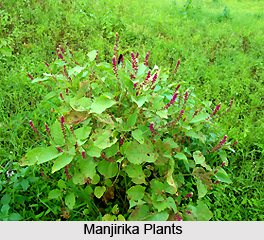Manjirika is botanically named as Achymnthes muricata. This common Indian medicinal plant is named as `gungatiyaluta` in West Bengal, `kanajaro` in Gujarat, `manjirika` in Sanskrit and `tandala` in Punjab.
 Manjirika is an annual herb. This plant is 30-60 centimetres high and has spreading branches. The leaves of this herb are varies from 2 centimetres to 7.5 centimetres in length and 1.3 centimetres to 4.5 centimetres in width. The leaves shape ovate or elliptic and are acute or rounded at the apex. Reddish margins are sometimes seen in the leaves. The flowers of manjirika are pink in colour. They are borne in threes in lax, are axillary and have pedunculate spikes that are 2.5 centimetres to 12.5 centimetres long. The fruits of manjirika are globose and are approximately 0.3 centimetres in diameter. The seeds are yellowish-brown in colour.
Manjirika is an annual herb. This plant is 30-60 centimetres high and has spreading branches. The leaves of this herb are varies from 2 centimetres to 7.5 centimetres in length and 1.3 centimetres to 4.5 centimetres in width. The leaves shape ovate or elliptic and are acute or rounded at the apex. Reddish margins are sometimes seen in the leaves. The flowers of manjirika are pink in colour. They are borne in threes in lax, are axillary and have pedunculate spikes that are 2.5 centimetres to 12.5 centimetres long. The fruits of manjirika are globose and are approximately 0.3 centimetres in diameter. The seeds are yellowish-brown in colour.
Manjirika is basically observed as a common weed in pastures, cultivated fields and wastelands almost throughout India. Ayurveda uses manjirika as a cooling, astringent to the bowels at first, but laxative in large doses. The flowers and seeds of manjirika are used to treat urinary discharges.



















